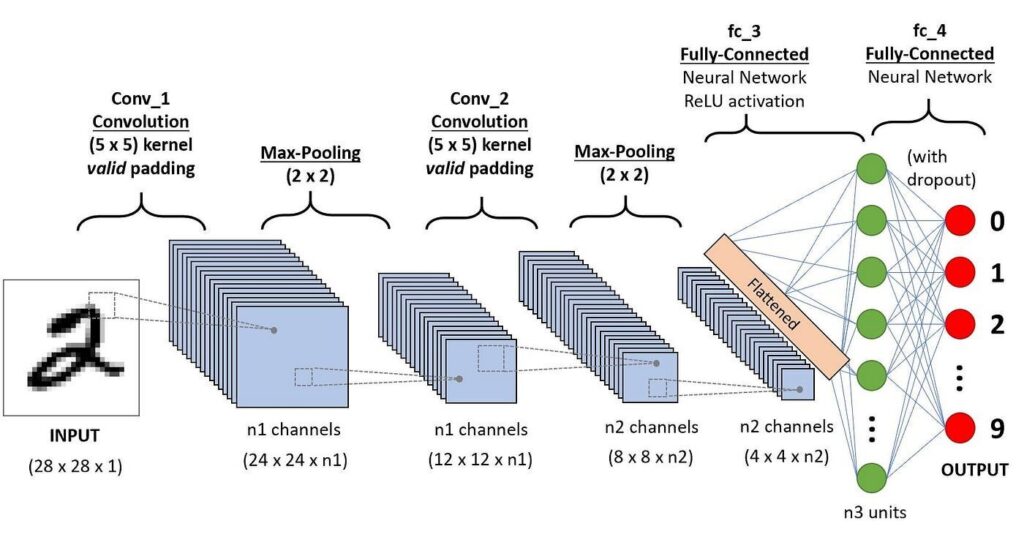Convolutional Neural Networks (CNNs), also known as ConvNets, are a specialized type of artificial neural network designed primarily for processing structured grid data, such as images. They have become a cornerstone in the field of computer vision due to their ability to automatically and adaptively learn spatial hierarchies of features through backpropagation.
Inspiration and Architecture
CNNs are inspired by the human visual system, particularly the visual cortex, which processes visual information in a hierarchical manner. This hierarchical architecture allows CNNs to detect simple features like edges in the early layers and more complex features like shapes and objects in the deeper layers[1][2].
Key Components
- Convolutional Layers: The core building block of a CNN, convolutional layers apply a set of filters (or kernels) to the input image. These filters slide over the input data and perform element-wise multiplications, producing a feature map that highlights specific patterns such as edges or textures[3][4].
- Pooling Layers: These layers reduce the spatial dimensions of the feature maps, thus decreasing the computational load and helping to make the detection process invariant to small translations of the input image. Common pooling operations include max pooling and average pooling[4].
- Fully Connected Layers: After several convolutional and pooling layers, the high-level reasoning in the neural network is done via fully connected layers. These layers take the high-level filtered images and convert them into a one-dimensional vector, which is then processed for classification or regression tasks[3][5].
Advantages of CNNs
- Automatic Feature Extraction: Unlike traditional image processing techniques that require manual feature extraction, CNNs automatically learn the features from the data, making them highly adaptable to different tasks[4].
- Translation Invariance: Through pooling layers, CNNs achieve a degree of translation invariance, meaning they can recognize objects in images regardless of their position[1].
- Parameter Sharing: The use of shared weights across different parts of the image reduces the number of parameters and computational complexity, making CNNs more efficient[5].
Applications
CNNs are widely used in various domains including:
- Image Classification: Identifying objects within images, such as recognizing handwritten digits or detecting faces[2].
- Object Detection: Locating and classifying multiple objects within an image.
- Medical Imaging: Assisting radiologists by identifying anomalies in medical scans[5].
Challenges
Despite their success, CNNs face several challenges:
- Overfitting: Due to their high capacity, CNNs can overfit to the training data, especially when the dataset is small. Techniques like data augmentation and dropout are used to mitigate this issue[1].
- Computational Demand: Training CNNs requires significant computational resources, often necessitating the use of GPUs[3].
In summary, CNNs represent a powerful and flexible approach to image processing tasks, leveraging their hierarchical structure and automatic feature learning capabilities to achieve state-of-the-art performance in various applications.
Further Reading
1. An Introduction to Convolutional Neural Networks: A Comprehensive Guide to CNNs in Deep Learning | DataCamp
2. [1511.08458] An Introduction to Convolutional Neural Networks
3. What are Convolutional Neural Networks? | IBM
4. Simple Introduction to Convolutional Neural Networks | by Matthew Stewart, PhD | Towards Data Science
5. Convolutional neural networks: an overview and application in radiology | Insights into Imaging | Full Text
Description:
Image and video analysis, object detection, and recognition
IoT Scenes:
Security cameras, smart surveillance, quality control in manufacturing.
Smart Surveillance: Image and video analysis for security cameras.
Quality Control: Defect detection in manufacturing using visual inspection.
Healthcare: Medical imaging analysis for diagnostics.
Autonomous Vehicles: Object detection and classification for navigation systems


